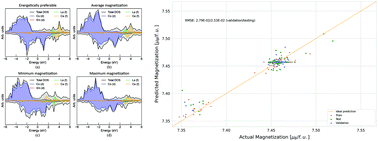Ab initio, artificial neural network predictions and experimental synthesis of mischmetal alloying in Sm–Co permanent magnets†
Abstract
The use of the mischmetal alloy, comprised of La and Ce in 1 : 3 ratio, as a partial substitute for Sm in the CaCu5-type structure is explored, as a means for the search of viable alternatives for permanent magnets that require fewer steps in the rare earth separation processing. The structural and magnetic properties of the introduced stoichiometry, containing 50% less Sm, are compared to the ones of the SmCo5, LaCo5 and CeCo5 binary compounds by means of ab initio simulations. The capability of artificial neural networks to accurately predict the relationship between structure and total magnetization from DFT calculations in the supercell approach that was employed, is also demonstrated. Experimental fabrication and structural and magnetic characterization of the proposed stoichiometry verifies the structural configuration and provides insight for the macroscopic hard magnetic properties of the material. The reduction of magnetic properties was found to be favorable compared to the respective reduction of the raw materials cost, while measurements of the Cure temperature verify that the proposed compound is still suitable for high temperature applications.



 Please wait while we load your content...
Please wait while we load your content...